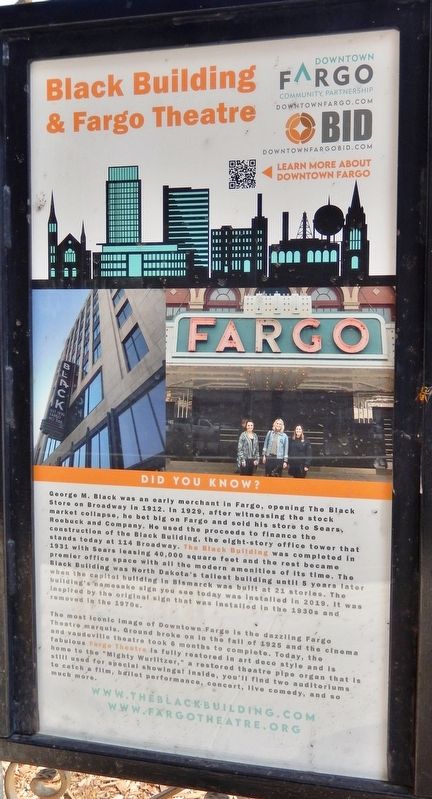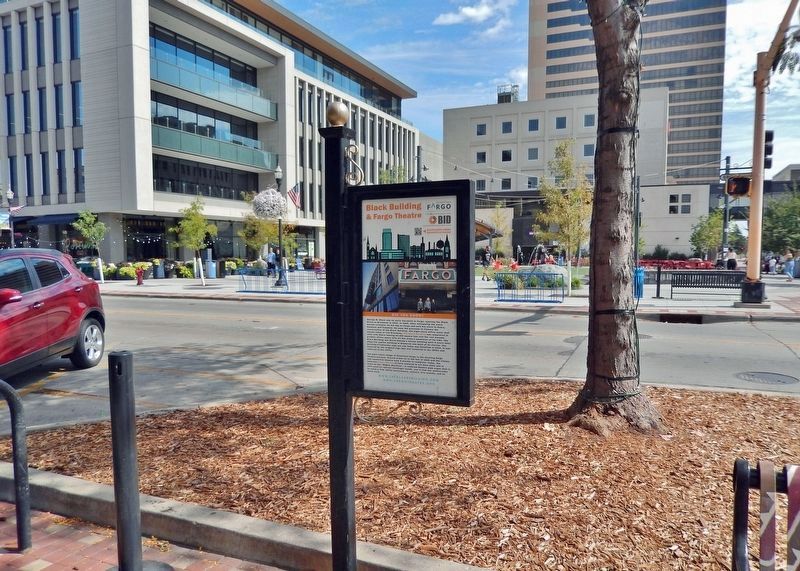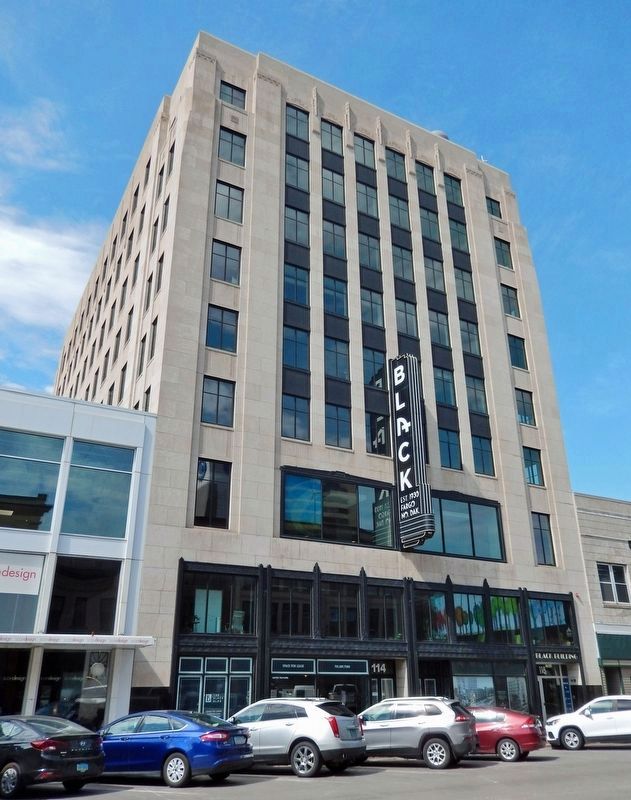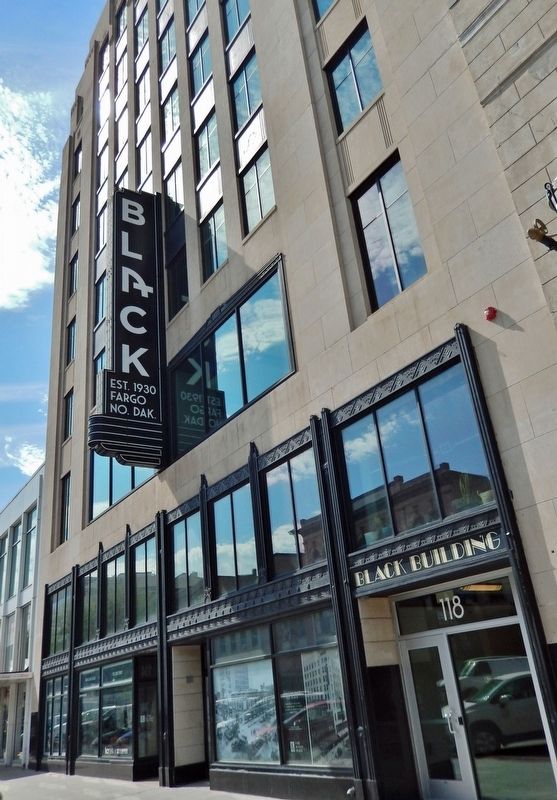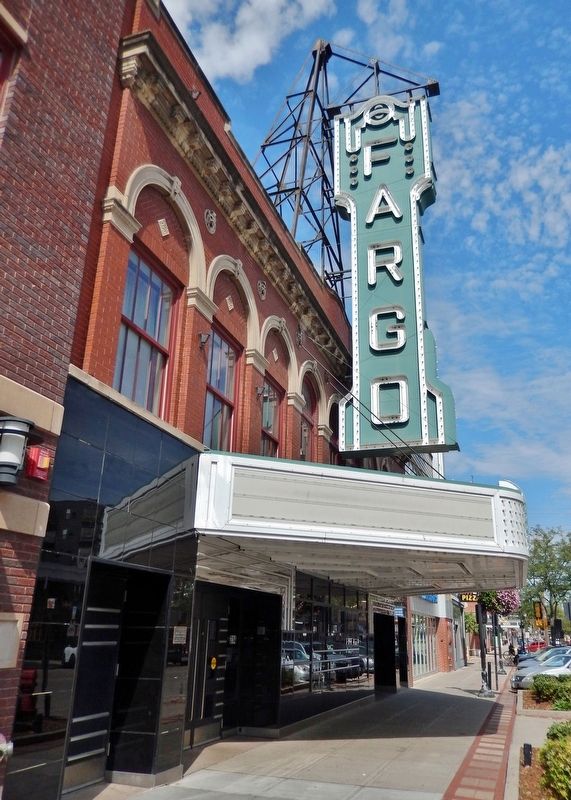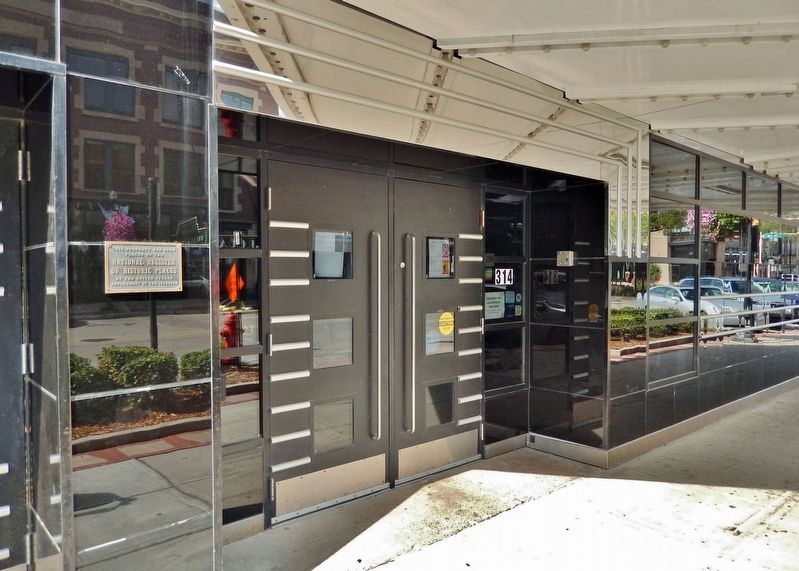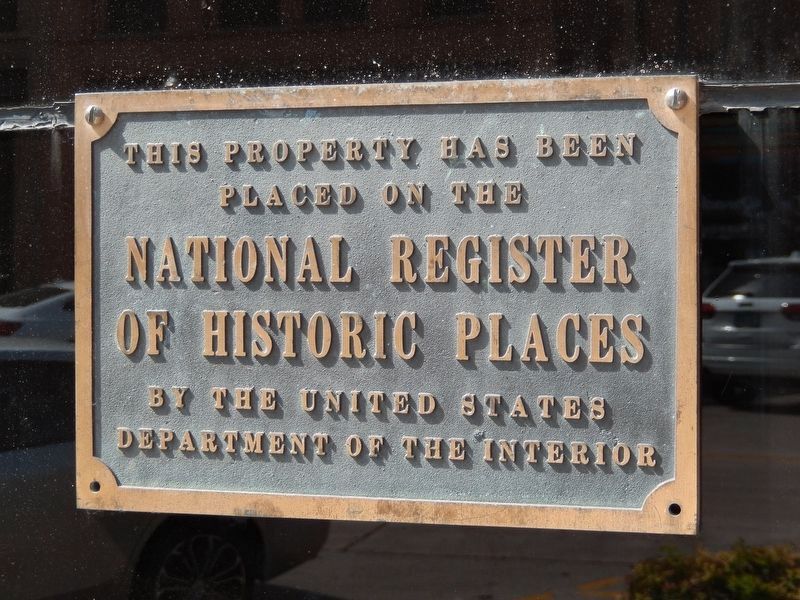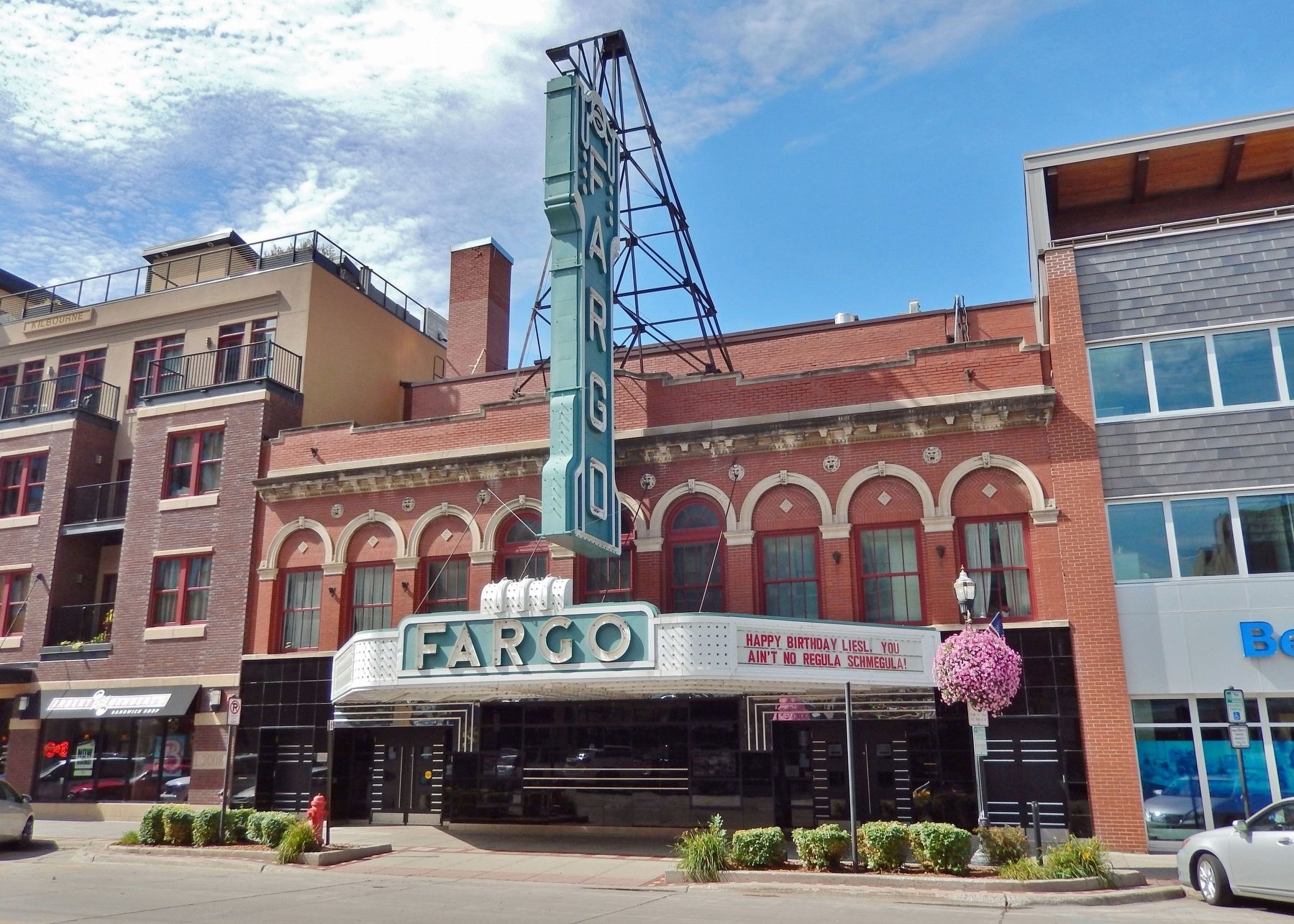Downtown in Fargo in Cass County, North Dakota — The American Midwest (Upper Plains)
Black Building & Fargo Theatre
George M. Black was an early merchant in Fargo, opening The Black Store on Broadway in 1912. In 1929, after witnessing the stock market collapse, he bet big on Fargo and sold his store to Sears Roebuck and Company. He used the proceeds to finance the construction of the Black Building, the eight-story office tower that stands today at 114 Broadway. The Black Building was completed in 1931 with Sears leasing 40,000 square feet and the rest became premier office space with all the modern amenities of its time. The Black Building was North Dakota's tallest building until 5 years later when the capitol building in Bismarck was built at 21 stories. The building's namesake sign you see today was installed in 2019. It was inspired by the original sign that was installed in the 1930s and removed in the 1970s.
The most iconic image of Downtown Fargo is the dazzling Fargo Theatre marquis. Ground broke on in the fall of 1925 and the cinema and vaudeville theatre took 6 months to complete. Today, the fabulous Fargo Theatre is fully restored in art deco style and is home to the "Mighty Wuriltzer," a restored theatre pipe organ that is still used for special showings! Inside, you'll find two auditoriums to catch a film, ballet performance, concert, live comedy, and so much more.
www.fargotheatre.org
Erected by Downtown Fargo Community Partnership.
Topics and series. This historical marker is listed in these topic lists: Architecture • Entertainment • Industry & Commerce • Notable Buildings. In addition, it is included in the Believe It or Not, and the National Register of Historic Places series lists.
Location. 46° 52.689′ N, 96° 47.269′ W. Marker is in Fargo, North Dakota, in Cass County. It is in Downtown. Marker is on Broadway North just north of 2nd Avenue North, on the left when traveling north. The marker is located beside the sidewalk, near the northwest corner of the intersection. Touch for map. Marker is at or near this postal address: 202 Broadway North, Fargo ND 58102, United States of America. Touch for directions.
Other nearby markers. At least 8 other markers are within walking distance of this marker. Steamboats on the Red River (a few steps from this marker); Wildlife in the Red River Valley (within shouting distance of this marker); Red River Valley (within shouting distance of this marker); Osco Drug (within shouting distance of this marker); Recreation on the Red River (within shouting distance of this marker); Plains Art Museum (about 400 feet away, measured in a direct line); Bonanza Farms
(about 400 feet away); NDSU Agriculture (about 400 feet away). Touch for a list and map of all markers in Fargo.
Regarding Black Building & Fargo Theatre.
The Black Building — National Register of Historic Places #16000821. Also a contributing property in Downtown Fargo Historic District, NRHP #83004064.
From the National Register Nomination:
Construction of the Black Building began in November of 1930, with its official grand opening in June, 1931. The building represents the Art Moderne style of architecture. The eight story structure was constructed of cast in place concrete and faced with Indiana limestone on the main façade and light brick on its other three sides. As was typical of the period, the Indiana limestone wraps around to the north and south elevations by one bay. The building stands eight stories, 122 feet tall, with the first two floors having taller floor to floor heights, typical of a retail use. The building housed the WDAY radio station on its eighth floor, while the first Sears department store in Fargo occupied its basement and first, balcony, and second floors until the mid-1970s. The building was commissioned by George Black, a local business owner who was a dominant figure in Fargo’s early 20th century retail landscape, and whose “one-cent sales” have been adopted by retailers across the country and are still used to this day.
The Black Building’s grand opening took place on June 11, 1931. The three day celebration included a gala on the opening night and gave anyone a chance to visit “the Northwest’s largest and most complete Department Store.” The event was large enough to warrant a sixteen page Black’s Store Section in The Fargo Forum newspaper, which provided details about the building and its construction, advertisements, and notes of congratulation from local businesses to George Black.
The Fargo Theatre — National Register of Historic Places #82001312. Also a contributing property in Downtown Fargo Historic District, NRHP #83004064.
From the National Register Nomination:
The significance of the Fargo Theatre is derived from its continuing association with the community as a social and entertainment center, from its unique blend of architectural styles, and from the forces and events that contributed to both. Constructed in 1926, the building was owned by T. F. Powers and Peter Elliott, prominent Fargo businessmen. Architects for the project were Buechner and Orth, a Twin Cities firm who had gained a reputation in the state by designing no less than 13 county courthouses. The Fargo Theatre was considered at the time of its construction to be the finest of nearly 100 theatres operated by the St. Paul firm of Finkelstein and Ruben, a vanguard in the motion picture industry. When uniformed attendants opened the doors on March 15, patrons were greeted with "brilliant lights, bewitching architectural beauty, and symphonic music." Booked for the auspicious opening was a customary blend of stage and screen entertainment, enhanced by the theatre's 10-piece concert orchestra. Since motion pictures had not yet learned the art of talking, a large new Wurlitzer Theatre organ allowed a talented organist the ability to interpret any mood or expression of the silent "photoplays." The theatre continued to offer a variety of shows through the years. In addition to silent movies (accompanied by the incomparable Hildigard on the mighty Wurlitzer) the Fargo accommodated numerous vaudeville acts, music reviews, high wire acts, and personal appearances by Hollywood stars. Notables featured include Babe Ruth, Boris Karloff, Lyle Talbot, Alan Dinehart, Glenda Farrell, Gig Young and Robert Young. Western star, Tom Mix, delighted audiences by appearing on stage with his horse.
Today the theatre has won the acclaim of historians studying the art deco style. WDAY utilized its exceptional acoustics for broadcasting and for talent shows well into the 1960's. As the only remaining general attraction theatre on Broadway, the Fargo is admired and enjoyed by many.
Also see . . .
1. Black Building (Wikipedia). Excerpts:
In 2016 it was listed on the National Register, as its "owners chose to pursue the honor of an individual listing for its architecture and for its association with George Mumford Black and his strategies in commerce and communications." Black had the upper floor of the Art Moderne building designed for WDAY (AM) radio and ensured the station signed off each show with “this is WDAY with from the Black Building, Fargo.” The Black building was the work of Lang, Raugland, and Lewis of Minneapolis with Ole A. Braseth and S. Marius Houkom, consulting Fargo architects.(Submitted on January 27, 2024, by Cosmos Mariner of Cape Canaveral, Florida.)
2. The Black Building. Excerpts:
Since several hundred people gathered to watch the cornerstone be placed on November 18, 1930, downtown Fargo’s Black Building has captured the imaginations of North Dakotan’s. The new building was once mentioned in Ripley’s “Believe it or Not” newspaper features because the Black Building was white. In 2019, a brand new 30-foot blade sign was added to the front face of the Black. Kilbourne Group was inspired by the original sign that graced the building, which lit up “BLACKS” in red letters over Broadway. “Blacks” referred to the original store in the building, which was later changed to “SEARS.” Today, the sign says Black in reference to the man who chose Fargo in 1912 and forever impacted the course of our history.(Submitted on January 27, 2024, by Cosmos Mariner of Cape Canaveral, Florida.)
3. Fargo Theatre (Wikipedia). Excerpt:
Construction on the building began in the fall of 1925 and the theatre opened on March 15, 1926. It was restored in 1999 to its historic appearance and now is a center for the arts in the Fargo-Moorhead metropolitan area. The Fargo Theatre is home to a 4-manual, 32-rank Wurlitzer Theatre Pipe Organ, known as the "Mighty Wurlitzer," which is owned and maintained by the Red River Theatre Organ Society, a non-profit organization and local chapter of the American Theatre Organ Society. Since 2001, The Fargo Theatre has served as the main venue of the Fargo Film Festival.(Submitted on January 27, 2024, by Cosmos Mariner of Cape Canaveral, Florida.)
4. About Fargo Theatre (www.fargotheatre.org). Excerpt:
Built in 1926 as a cinema and vaudeville theatre, the beautifully restored Fargo Theatre now serves as an art house theatre featuring independent and foreign film. The Theatre is also Fargo’s hottest downtown venue for concerts and other live events. In spring of 2009, the Fargo Theatre opened a second auditorium to increase our offering of film and event programming. The Fargo Theatre is a non-profit organization and was placed on the National Register of Historical Places by the United States Department of the Interior.(Submitted on January 27, 2024, by Cosmos Mariner of Cape Canaveral, Florida.)
5. Fargo Theatre (Cinema Treasures). Excerpt:
This beautiful theatre was originally opened on March 15, 1926 by the Finkelstein & Ruben chain. Its first movie played was “The Man on the Box” staring Syd Chaplin and directed by Charles Resiner. Remodeled in 1937 by architects Liebenberg & Kaplan in an Art Deco style, with 1,124 seats. For years it has been home to a twice annual silent movie night, in which classics like the “Phantom of the Opera”, “Ella Cinders”, “The Thief of Bagdad”, and “The General” are accompanied by an original live score on the Fargo’s mighty Wurlitzer pipe organ.(Submitted on January 27, 2024, by Cosmos Mariner of Cape Canaveral, Florida.)
Credits. This page was last revised on January 31, 2024. It was originally submitted on January 26, 2024, by Cosmos Mariner of Cape Canaveral, Florida. This page has been viewed 130 times since then. Photos: 1, 2, 3, 4, 5, 6, 7, 8. submitted on January 27, 2024, by Cosmos Mariner of Cape Canaveral, Florida.
